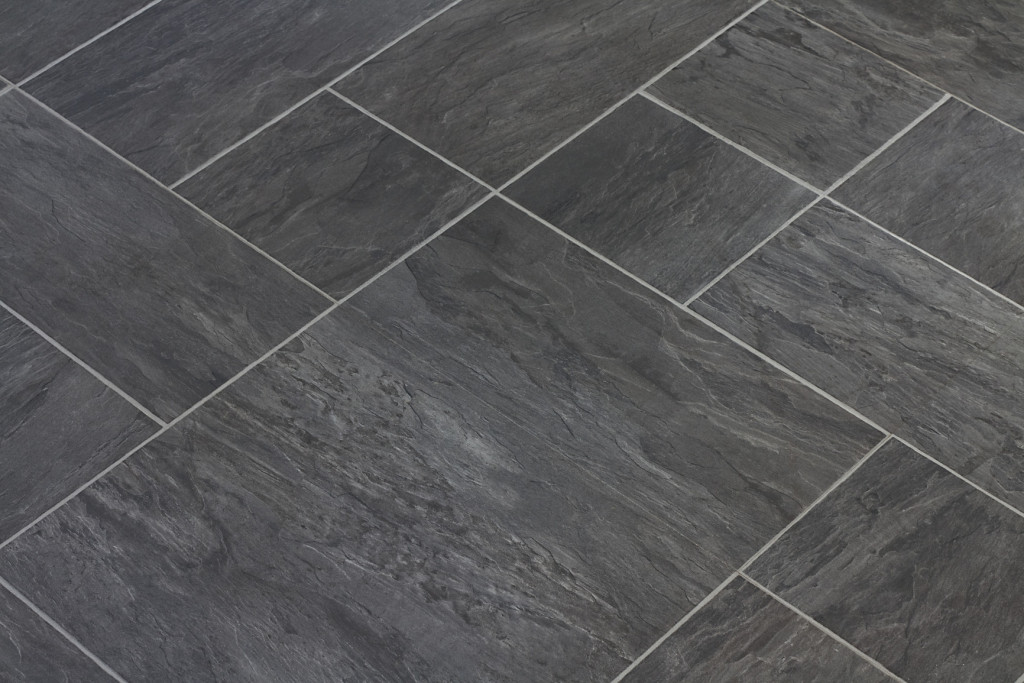Shopping for flooring can feel overwhelming. With so many options, it can be challenging to determine which one is best for your mobile home or recreational vehicle (RV).
As you research and compare flooring products online, you will likely come across luxury vinyl tile (LVT) and vinyl composition tile (VCT). These two types of flooring are commonly used in residential and commercial settings. They are also very popular among homeowners who value durability, style and functionality.
LVT and VCT flooring are often confused because they share some similarities. However, these flooring types differ in significant ways. Understanding these differences can help you make an informed decision about the type of flooring to purchase for your RV, mobile home, or modular home.

What Is LVT Flooring?
Luxury vinyl tile (LVT) is a high-performance, versatile flooring option. It’s used in various settings, from homes, apartments, and RVs to offices, stores, schools, and healthcare facilities. LVT is so named because it can replicate the appearance of “luxury” materials like hardwood, stone, terrazzo, and ceramic.
What Is LVT Flooring Made Of?
LVT, or Luxury Vinyl Tile, is composed of four distinct layers.
- Protective Wear/Top Layer: The top layer protects against scratches, scuffs, and daily wear. Enhanced with a urethane or aluminum oxide coating, it ensures a long-lasting surface that’s also easy to clean.
- Vinyl Core: The core, made of durable vinyl, provides strength and stability. Its moisture-resistant properties make LVT a practical choice for areas prone to spills or humidity.
- Printed Design/Decorative Layer: This layer features high-resolution printed designs that mimic the look of wood, stone, concrete, ceramic, and marble.
- Backing: The backing forms the tile’s base, providing stability and comfort underfoot. It also helps with noise reduction and adds an extra layer of moisture protection.
These four layers combine to make LVT a versatile and attractive flooring choice for many spaces.
Durability and Performance
One of the reasons LVT is so popular among homeowners is because of its remarkable durability. It’s highly resistant to moisture, scratches, and wear and tear, making it an ideal choice for homes with limited space and high traffic. Whether in the kitchen or bathroom, LVT can withstand spills and moisture without warping or buckling.
Installation Process
LVT is also known for its ease of installation, making it a popular choice among DIY enthusiasts. It comes in floating floor systems, peel-and-stick varieties, and glue-down options. Most installations require few tools, making them a great weekend project for those who want to tackle home improvements themselves.
Cost
LVT falls within the mid-range price bracket, offering excellent value for its design appeal and longevity. It’s a cost-effective alternative to expensive hardwood or ceramic tiles, providing homeowners with a luxurious look at a fraction of the cost.
Environmental Impact
Many LVT manufacturers offer eco-friendly options, such as low-VOC (volatile organic compound) emissions and recyclable materials. For homeowners concerned about the environmental footprint of their flooring, it’s worthwhile to look for these sustainable alternatives.
What Is VCT Flooring?
Vinyl composition tile (VCT) is a resilient flooring material composed of vinyl and limestone. It is commonly used in commercial spaces. While available in various colors and patterns, VCT doesn’t offer the same design versatility as LVT. Instead, its appearance tends to be more utilitarian, making it a practical choice for high-traffic areas like hallways, laundry rooms, or utility spaces.
What Is VCT Flooring Made Of?
VCT is composed primarily of vinyl resins and limestone fillers, which gives it a dense, rigid structure. Unlike LVT, which has multiple layers, VCT is homogeneous, which means it is composed of a single layer.
Durability and Performance
The high percentage of limestone in the mix makes VCT particularly hard and durable. It is highly resistant to wear and tear and even heavy foot traffic, so it’s often used in commercial settings.
However, VCT flooring is more susceptible to water damage and staining if not properly sealed. Regular sealing and waxing are essential to maintain its durability and appearance over time, which can add to its maintenance costs.
Installation Process
Installing VCT is typically more labor-intensive than LVT. It requires adhesives to secure the tiles to the subfloor, precise leveling to ensure a smooth surface, and professional expertise to handle the rigid material properly.
Additionally, VCT needs to be sealed, waxed, and polished after installation to protect the surface and enhance its durability. Because of the specialized equipment, tools, and skills needed, installing VCT flooring is not recommended as a DIY project.
Cost
VCT is generally more affordable upfront than LVT, making it a budget-friendly option for homeowners seeking a low-cost flooring solution. However, the ongoing maintenance costs, such as sealing, waxing, and polishing, may offset the initial savings over time.
Environmental Impact
VCT offers fewer eco-friendly options than LVT. The material composition and the need for frequent maintenance products can increase its environmental footprint. Additionally, it generates more waste due to the need for replacements or refinishing when it gets damaged.
What Is the Difference between LVT and VCT Flooring?
Material Composition
The main distinction between LVT vs. VCT is the materials used to make them. LVT’s layered composition allows for greater flexibility and realistic design options. In contrast, VCT is a homogenous material made from vinyl and limestone, resulting in a more rigid and functional design.
Aesthetic Appeal
Another difference between VCT vs. LVT is aesthetics. When it comes to style, VCT is the clear winner. Its ability to mimic various premium materials makes it ideal for homeowners seeking a fashionable flooring solution. VCT, on the other hand, has a somewhat plain appearance. While VCT flooring comes in several colors and patterns, it doesn’t offer the same level of customization as LVT.
Maintenance Requirements
Maintenance needs vary significantly between LVT vs. VCT.
LVT requires minimal upkeep, with regular sweeping and occasional mopping being sufficient to keep it looking fresh. It’s scratch-resistant and doesn’t need sealing or waxing.
VCT, however, needs frequent sealing, waxing, and polishing to maintain its appearance and longevity. Without regular maintenance, it can quickly show signs of wear and tear.
Water Resistance
LVT is naturally water-resistant, making it an excellent choice for moisture-prone areas like kitchens and bathrooms in RVs and mobile homes. VCT, while durable, needs proper sealing to resist water and can be vulnerable to moisture if not maintained correctly.
Durability and Longevity
Both LVT and VCT offer durability, but LVT’s low maintenance and water resistance give it an edge in longevity, especially in homes with pets, children, or heavy foot traffic. VCT can last long in high-traffic areas but requires regular care.
Comfort and Noise Absorption
LVT provides a softer, quieter surface, which is important for homeowners seeking comfort and noise reduction. VCT, being more rigid, may not absorb noise as effectively. It can also feel harder underfoot.
Installation Process
LVT is easier to install for those seeking DIY-friendly flooring, with options like peel-and-stick and floating systems. VCT, by comparison, usually requires professional installation due to its more labor-intensive process.
VCT vs. LVT: Which is Better for RVs and Mobile or Modular Homes?
When choosing between LVT vs. VCT, it helps to consider the following factors:
Space Considerations
LVT is better suited for living areas, kitchens, and bathrooms where aesthetics and performance are essential. It offers a luxurious appearance with the practicality of low maintenance. VCT is ideal for utility spaces or high-traffic areas that don’t require elaborate designs but need a durable solution.
Lifestyle Factors
LVT is an excellent choice for homeowners who prioritize modern design and easy maintenance. Its water resistance, durability, and versatility make it perfect for homes with pets, children, or frequent visitors. Meanwhile, VCT is well-suited for those on a strict budget or who need basic flooring in functional areas.
Budget Considerations
VCT offers a lower initial cost but requires more upkeep, while LVT provides long-term savings due to its durability and minimal maintenance needs. Homeowners should consider both the upfront cost and the long-term expenses when choosing between the two.
Longevity and Resale Value
LVT’s premium appearance and long-lasting durability can enhance the resale value of an RV, mobile, or modular home. VCT, though functional, may show wear over time and is less likely to increase a home’s market appeal.
Shop Online at Basic Components for Your Flooring Needs
Both LVT and VCT have advantages, but the choice ultimately depends on your home’s needs, lifestyle, and budget. LVT offers luxury, durability, and low maintenance, making it ideal for homeowners looking for a long-term investment. Meanwhile, VCT provides a cost-effective solution but requires more upkeep to maintain its appearance and durability.
Basic Components offers a wide range of flooring products for RVs, mobile homes, and modular houses. Whether you’re looking for the luxury of LVT or the practicality of VCT, you can count on us to provide flooring solutions that meet your needs. Explore our products online and place your order today. You may also contact us at 1-(800) 452-1780 for more information.

